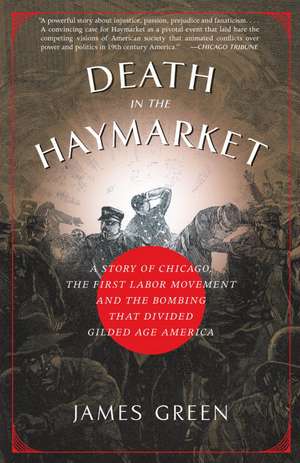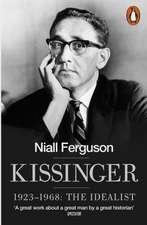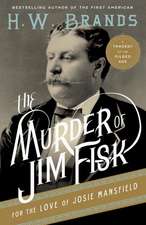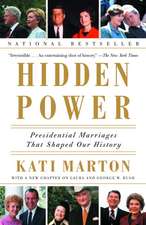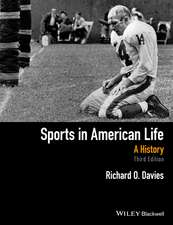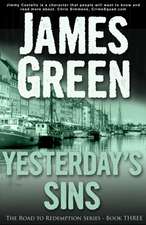Death in the Haymarket: A Story of Chicago, the First Labor Movement and the Bombing That Divided Gilded Age America
Autor James Greenen Limba Engleză Paperback – 28 feb 2007
Preț: 102.06 lei
Nou
Puncte Express: 153
Preț estimativ în valută:
19.53€ • 20.44$ • 16.16£
19.53€ • 20.44$ • 16.16£
Carte disponibilă
Livrare economică 15-29 martie
Preluare comenzi: 021 569.72.76
Specificații
ISBN-13: 9781400033225
ISBN-10: 1400033225
Pagini: 383
Ilustrații: 56 ILUSTRATIONS
Dimensiuni: 131 x 204 x 20 mm
Greutate: 0.37 kg
Editura: Anchor Books
ISBN-10: 1400033225
Pagini: 383
Ilustrații: 56 ILUSTRATIONS
Dimensiuni: 131 x 204 x 20 mm
Greutate: 0.37 kg
Editura: Anchor Books
Notă biografică
James Green is a professor of history at the University of Massachusetts Boston. He grew up outside of Chicago and now lives with his family in Somerville, Massachusetts.
Extras
For Once in Common Front
MAY 1, 1865-MAY 1, 1867
THE FIRST OF MAY was by custom a day of hope that marked the coming of spring, a day when children danced and twirled streamers around a Maypole. But in 1865 it was the gloomiest day Chicago had ever seen. For on that occasion "the merry May pole gaily wreathed for the holiday festivities of exuberant life" yielded its place to the "funeral catafalque draped with Death's sad relics." So wrote Abraham Lincoln's friend and ally Joseph Medill in the Chicago Tribune that morning of the day when the multitudes would assemble "to do honor to the great and good King of men," severed from his people when he was "slain so ruthlessly."
In the dark hours of the early morning, crowds gathered all along the Illinois Central tracks on the lakeside. A light rain fell as the funeral train entered Chicago that morning; it hissed to a stop at Michigan Avenue and 12th Street, where 36,000 citizens had gathered to meet it. An honor guard loaded the presidential coffin onto an elaborate horse-drawn hearse, and citizens formed in military rank behind it. A group of thirty-six "maidens dressed in white" surrounded the carriage as it passed through an imposing Gothic arch dedicated to the "Martyr for Justice." After each young woman placed a red rose on the president's coffin, the carriage pulled away, followed by the column of Chicagoans who marched four abreast up Michigan Avenue toward the courthouse, where their martyred president's remains would lie in state. The procession grew to 50,000 as it moved slowly up the lakeside. Along the way twice that many people lined the streets. From all over the Northwest they came-by train, in wagons and buggies and on horseback, all united in silent grief. "In the line of march and looking on, sharing something in common," Carl Sandburg wrote, were native-born Yankees and foreign-born Catholics, blacks and whites, German Lutherans and German Jews-all "for once in common front."
Up Michigan Avenue they trod in rhythm to the sound of drums beating in solemn tribute to Lincoln's memory, expressing, as the Tribune put it, "the devotion with which all classes looked up to him." A military band led the funeral procession of five divisions: first came the Board of Education and 5,000 schoolchildren, and then military officers and enlisted men, the combat troops of the Grand Army of the Republic led by the Old Batteries of the Chicago Light Artillery, whose cannon had laid siege to Atlanta. The black-coated men of the Board of Trade headed the next division, which also featured groups from various ethnic lodges, including 200 of the Turner gymnasts dressed in white linen. Contingents of workingmen followed, paying their respects to a president who said he was not ashamed that he had once been "a hired laborer, mauling rails, on a flatboat-just what might happen to any poor man's son!" Nearly 300 members from the Journeymen Stonecutters' Association walked behind a banner with two sides, one reading in union there is strength and the other proclaiming we unite to protect not to injure.
All through that night of May 1 and well into the next day, mourners stood in the mud and drizzle waiting to file through the courthouse for a last look at the man whose storied path to the White House had so often passed through their city. On May 2, after 125,000 people had gazed upon the face of their departed president, his coffin was escorted to St. Louis Depot on Canal Street by another elaborately organized procession led by a chorus of 250 Germans singing dirges. Lincoln's corpse was placed inside its specially built car, and at 9:30 a.m. the funeral train pulled out of the depot carrying Illinois's "noblest son" to his final destination in Springfield, leaving behind a city whose people he had unified in life and, far more so, in death.
After its journey through the cornfields and little prairie towns Lincoln had visited as a lawyer and campaigner, the funeral train arrived in Springfield. The president's body was buried the next day in Oak Ridge Cemetery, where the eulogist recalled the late Civil War as a momentous "contest for human freedom . . . not for this Republic merely, not for the Union simply, but to decide whether the people, as a people, were destined . . . to be subject to tyrants or aristocrats or class rule of any kind."
Leading Illinois Republicans who gathered at Lincoln's grave on May 4, 1865, rejoiced that free labor had triumphed over the slave system in that great war now won. They believed a new nation had emerged from the bloody conflict, new because now all of its people were "wholly free." The 4 million bondsmen the "martyred emancipator" had liberated were, said the Tribune, a living epistle to Lincoln's immortality. But were all the people now wholly free?
IN THE YEARS after Lincoln's death, emancipated slaves found many compelling reasons to question the meaning of their new freedom in the face of the reign of white terror that descended upon them. At the same time, for quite different reasons, workingmen, the very mechanics who benefited most from the free labor system Lincoln had extolled, began to doubt the nature of their liberty. A few months before the war ended, the nation's most influential trade union leader, William H. Sylvis, came to Chicago and sounded an alarm that echoed in many labor newspapers in the closing months of the war. The president of the powerful Iron Molders' International Union excoriated employers who took advantage of the war emergency to fatten their profits while keeping their employees on lean wages. When union workers protested with strikes, politicians called them traitors, soldiers drove them back to work, and many loyal union men were fired and blacklisted by their bosses in retaliation. How, Sylvis asked, could a republic at war with the principle of slavery make it a felony for a workingman to exercise his right to protest, a right President Lincoln had once celebrated as the emblem of free labor? "What would it profit us, as a nation," the labor leader wondered, if the Union and its Constitution were preserved but essential republican principles were violated? If the "greasy mechanics and horny-handed sons of toil" who elected Abe Lincoln became slaves to work instead of self-educated citizens and producers, what would become of the Republic?
Sylvis told his iron molders that tyranny was based upon ignorance compounded by "long hours, low wages and few privileges," while liberty was founded on education and free association among workingmen. Only when wage earners united could they achieve individual competence and independence. Only then would they exercise a voice in determining their share of the increased wealth and the expanded freedom that would come to the nation after the war.
America had never produced a labor leader as intelligent, articulate and effective as William Sylvis. Born in western Pennsylvania to parents in humble circumstances, young William was let out as a servant to a wealthy neighbor who sent him to school and gave him the key to a good library. Later, after helping in his father's wagon shop, Sylvis apprenticed himself to a local iron foundry owner, a master craftsman who taught his young helper the ancient arts of smelting and smithing and the methods of making molten iron flow into wooden molds to shape the iron products he had designed. After he married, the young molder moved to Philadelphia to ply his trade, but he found it a struggle working long hours every day to provide for his family and failing to rise above the level of manual laborer.
William Sylvis found another way to raise himself up. He became secretary of his local union in 1859, and then two years later secretary of the new National Union of Iron Molders. By this time Sylvis had decided that mechanics were losing their independence and respectability because certain owners monopolized branches of industry and used their power to reduce wages. The rugged individualist was no match against these men who used money and political clout to advance themselves at the expense of their employees. "Single-handed, we can accomplish nothing," he wrote, "but united there is no power of wrong we may not openly defy."
In these years before the Civil War, however, prospects for a united labor movement were bleak. Only a few unions, like those of printers, machinists and locomotive engineers, had created national organizations. Most trade unions functioned within local settings where they had been formed by craftsmen who still dreamed of being masters and proprietors of their own shops and employers of their own helpers. These artisans often used radical language to denounce the merchant capitalists, bankers and monopolists, the "purse proud aristocrats" and "blood sucking parasites" who lived off the honest producers. Yet antebellum labor unionists, even radicals, tended to be craft-conscious more than class-conscious, barring females and free blacks from their associations and turning their backs on the women, children and immigrant "wage slaves" who toiled in factories.
Before 1860 common laborers and factory workers rarely formed lasting unions, and when they took concerted action, it was usually to resist wage cuts rather than to force employers to recognize their organizations. Their strikes were often ritualistic protests that rarely involved violent conflicts. The one cause that brought diverse groups of workers together was the campaign to shorten the workday to ten hours. Initiated by journeymen carpenters and women textile workers in 1835, the crusade gained thousands of adherents in northern shops and factories and then faded in the 1850s. Middle-class reformers and politicians took up the cause and lobbied for ten-hour laws in legislative halls, but their moderate arguments for shorter hours failed to produce effective laws. At the onset of the Civil War the ten-hour movement was dead.
When northern artisans and mechanics left the shops to join the federal armed forces in 1861, trade unions all but disappeared. The largest group of Union soldiers consisted of farmers, but as more and more troops were conscripted, workingmen constituted a growing proportion of the northern armed forces, so that by the end of the war 421 of every 1,000 soldiers who served in the northern ranks were wage workers, as compared to 35 of every 1,000 who listed business and commercial occupations. With their sons, brothers, cousins and neighbors dying on southern battlefields, those mechanics who remained at work fashioning and feeding the Union war machine found themselves working shorthanded and toiling harder than ever for greenback wages that could not keep up with astounding increases in the cost of fuel, rent and foodstuffs.
William Sylvis was well aware of these conditions when he became his union's national president in 1863. And so, as the War Between the States raged on, he decided it was time to bring the union back to the foundries, even if he had to do it single-handedly. He was thirty-six years old by then, "a medium-sized man, strongly built, of florid complexion, light beard and moustache, and a face and eyes beaming with intelligence," wrote one reporter. Still lean from his days at the forge, he drove himself mercilessly, giving speech after speech in a passionate style of oratory. That year he visited more than 100 foundries and organized many new locals. He wore the same suit until it became threadbare, and the scarf he wore was filled with little holes burned in it by the splashing of molten iron.
With tenacity and boundless energy, William Sylvis rebuilt the Molders' Union into the strongest in the country, creating the first effectively administered national organization in history, with a dues-collection system, a real treasury and a strike fund. "From a mere pigmy, our union has grown in one short year to be a giant," he reported, "like a mighty oak with branches stretching out in every direction."
By 1865, when Sylvis addressed his national convention in Chicago, he reported that nearly all the foundry owners in the nation had agreed to employ only molders who held a union card. One of the strongest local unions of iron molders flourished at Chicago's premier manufacturing plant, the farm reaper works owned and operated by Cyrus and Leander McCormick. Their employees struck four times for wage increases in 1863 and 1864, and won each time. Plant managers reported feeling powerless to resist the well-organized molders. When the Civil War ended, Sylvis's molders constituted the vanguard of what promised to become the nation's first coordinated union movement, a new army of labor. Trade union officers like Sylvis were painfully aware, however, that powerful forces had already been mobilized to block their advance.
DURING THE WAR the iron molders and other trade unionists encountered new employers' associations formed to resist any union demands for wage increases or reduced hours; these groups usually succeeded in destroying the fledgling labor unions by imposing lockouts and breaking strikes. Once they gained the upper hand, united employers fired and blacklisted union men and demanded that those who returned to work sign "yellow-dog contracts" promising not to rejoin the union. This coordinated opposition from employers frightened Sylvis and convinced him that a violent collision between labor and capital was coming. He concluded that union workers needed a national labor federation "to protect the rights of mechanics from being trammeled throughout the length and breadth of the land."
In charting a new course for the postbellum era, William Sylvis needed the help of a good navigator. He found one in Andrew C. Cameron of Chicago, the editor of a feisty labor newspaper called the Workingman's Advocate. Cameron had already been a combatant in early skirmishes with employers that broke out in Chicago while the Civil War still raged. He had come to America from Scotland as a young printer's apprentice, having learned the trade from his father in Berwick-on-Tweed, a historic center of Scottish resistance to English rule. He grew up during a time when the North Country was awash with a great mass movement for a People's Charter that would democratize the English Parliament and legalize universal manhood suffrage. The Chartist movement left a legacy that many English and Scottish workers carried to America: a tradition of questioning the new industrialism and of proposing checks on the free play of the market-all this based on an outlook with a "dangerous tenet: that production must be, not for profit, but for use."
After securing a position as a printer for the Chicago Times in 1860, Cameron emerged as the leader of a wartime strike against the paper's imperious publisher, Wilbur F. Storey, who had dismissed his union printers in order to hire cheaper hands. Unable to state their case in the city's daily papers, the strikers formed their own opposition newspaper, the Workingman's Advocate, "devoted exclusively to the interests of the producing classes," and asked Andrew Cameron to be its editor. It was a task he performed with all the "vim and independence characteristic of a Scotch Covenanter who hated tyranny and oppression from what ever source."
From the Hardcover edition.
MAY 1, 1865-MAY 1, 1867
THE FIRST OF MAY was by custom a day of hope that marked the coming of spring, a day when children danced and twirled streamers around a Maypole. But in 1865 it was the gloomiest day Chicago had ever seen. For on that occasion "the merry May pole gaily wreathed for the holiday festivities of exuberant life" yielded its place to the "funeral catafalque draped with Death's sad relics." So wrote Abraham Lincoln's friend and ally Joseph Medill in the Chicago Tribune that morning of the day when the multitudes would assemble "to do honor to the great and good King of men," severed from his people when he was "slain so ruthlessly."
In the dark hours of the early morning, crowds gathered all along the Illinois Central tracks on the lakeside. A light rain fell as the funeral train entered Chicago that morning; it hissed to a stop at Michigan Avenue and 12th Street, where 36,000 citizens had gathered to meet it. An honor guard loaded the presidential coffin onto an elaborate horse-drawn hearse, and citizens formed in military rank behind it. A group of thirty-six "maidens dressed in white" surrounded the carriage as it passed through an imposing Gothic arch dedicated to the "Martyr for Justice." After each young woman placed a red rose on the president's coffin, the carriage pulled away, followed by the column of Chicagoans who marched four abreast up Michigan Avenue toward the courthouse, where their martyred president's remains would lie in state. The procession grew to 50,000 as it moved slowly up the lakeside. Along the way twice that many people lined the streets. From all over the Northwest they came-by train, in wagons and buggies and on horseback, all united in silent grief. "In the line of march and looking on, sharing something in common," Carl Sandburg wrote, were native-born Yankees and foreign-born Catholics, blacks and whites, German Lutherans and German Jews-all "for once in common front."
Up Michigan Avenue they trod in rhythm to the sound of drums beating in solemn tribute to Lincoln's memory, expressing, as the Tribune put it, "the devotion with which all classes looked up to him." A military band led the funeral procession of five divisions: first came the Board of Education and 5,000 schoolchildren, and then military officers and enlisted men, the combat troops of the Grand Army of the Republic led by the Old Batteries of the Chicago Light Artillery, whose cannon had laid siege to Atlanta. The black-coated men of the Board of Trade headed the next division, which also featured groups from various ethnic lodges, including 200 of the Turner gymnasts dressed in white linen. Contingents of workingmen followed, paying their respects to a president who said he was not ashamed that he had once been "a hired laborer, mauling rails, on a flatboat-just what might happen to any poor man's son!" Nearly 300 members from the Journeymen Stonecutters' Association walked behind a banner with two sides, one reading in union there is strength and the other proclaiming we unite to protect not to injure.
All through that night of May 1 and well into the next day, mourners stood in the mud and drizzle waiting to file through the courthouse for a last look at the man whose storied path to the White House had so often passed through their city. On May 2, after 125,000 people had gazed upon the face of their departed president, his coffin was escorted to St. Louis Depot on Canal Street by another elaborately organized procession led by a chorus of 250 Germans singing dirges. Lincoln's corpse was placed inside its specially built car, and at 9:30 a.m. the funeral train pulled out of the depot carrying Illinois's "noblest son" to his final destination in Springfield, leaving behind a city whose people he had unified in life and, far more so, in death.
After its journey through the cornfields and little prairie towns Lincoln had visited as a lawyer and campaigner, the funeral train arrived in Springfield. The president's body was buried the next day in Oak Ridge Cemetery, where the eulogist recalled the late Civil War as a momentous "contest for human freedom . . . not for this Republic merely, not for the Union simply, but to decide whether the people, as a people, were destined . . . to be subject to tyrants or aristocrats or class rule of any kind."
Leading Illinois Republicans who gathered at Lincoln's grave on May 4, 1865, rejoiced that free labor had triumphed over the slave system in that great war now won. They believed a new nation had emerged from the bloody conflict, new because now all of its people were "wholly free." The 4 million bondsmen the "martyred emancipator" had liberated were, said the Tribune, a living epistle to Lincoln's immortality. But were all the people now wholly free?
IN THE YEARS after Lincoln's death, emancipated slaves found many compelling reasons to question the meaning of their new freedom in the face of the reign of white terror that descended upon them. At the same time, for quite different reasons, workingmen, the very mechanics who benefited most from the free labor system Lincoln had extolled, began to doubt the nature of their liberty. A few months before the war ended, the nation's most influential trade union leader, William H. Sylvis, came to Chicago and sounded an alarm that echoed in many labor newspapers in the closing months of the war. The president of the powerful Iron Molders' International Union excoriated employers who took advantage of the war emergency to fatten their profits while keeping their employees on lean wages. When union workers protested with strikes, politicians called them traitors, soldiers drove them back to work, and many loyal union men were fired and blacklisted by their bosses in retaliation. How, Sylvis asked, could a republic at war with the principle of slavery make it a felony for a workingman to exercise his right to protest, a right President Lincoln had once celebrated as the emblem of free labor? "What would it profit us, as a nation," the labor leader wondered, if the Union and its Constitution were preserved but essential republican principles were violated? If the "greasy mechanics and horny-handed sons of toil" who elected Abe Lincoln became slaves to work instead of self-educated citizens and producers, what would become of the Republic?
Sylvis told his iron molders that tyranny was based upon ignorance compounded by "long hours, low wages and few privileges," while liberty was founded on education and free association among workingmen. Only when wage earners united could they achieve individual competence and independence. Only then would they exercise a voice in determining their share of the increased wealth and the expanded freedom that would come to the nation after the war.
America had never produced a labor leader as intelligent, articulate and effective as William Sylvis. Born in western Pennsylvania to parents in humble circumstances, young William was let out as a servant to a wealthy neighbor who sent him to school and gave him the key to a good library. Later, after helping in his father's wagon shop, Sylvis apprenticed himself to a local iron foundry owner, a master craftsman who taught his young helper the ancient arts of smelting and smithing and the methods of making molten iron flow into wooden molds to shape the iron products he had designed. After he married, the young molder moved to Philadelphia to ply his trade, but he found it a struggle working long hours every day to provide for his family and failing to rise above the level of manual laborer.
William Sylvis found another way to raise himself up. He became secretary of his local union in 1859, and then two years later secretary of the new National Union of Iron Molders. By this time Sylvis had decided that mechanics were losing their independence and respectability because certain owners monopolized branches of industry and used their power to reduce wages. The rugged individualist was no match against these men who used money and political clout to advance themselves at the expense of their employees. "Single-handed, we can accomplish nothing," he wrote, "but united there is no power of wrong we may not openly defy."
In these years before the Civil War, however, prospects for a united labor movement were bleak. Only a few unions, like those of printers, machinists and locomotive engineers, had created national organizations. Most trade unions functioned within local settings where they had been formed by craftsmen who still dreamed of being masters and proprietors of their own shops and employers of their own helpers. These artisans often used radical language to denounce the merchant capitalists, bankers and monopolists, the "purse proud aristocrats" and "blood sucking parasites" who lived off the honest producers. Yet antebellum labor unionists, even radicals, tended to be craft-conscious more than class-conscious, barring females and free blacks from their associations and turning their backs on the women, children and immigrant "wage slaves" who toiled in factories.
Before 1860 common laborers and factory workers rarely formed lasting unions, and when they took concerted action, it was usually to resist wage cuts rather than to force employers to recognize their organizations. Their strikes were often ritualistic protests that rarely involved violent conflicts. The one cause that brought diverse groups of workers together was the campaign to shorten the workday to ten hours. Initiated by journeymen carpenters and women textile workers in 1835, the crusade gained thousands of adherents in northern shops and factories and then faded in the 1850s. Middle-class reformers and politicians took up the cause and lobbied for ten-hour laws in legislative halls, but their moderate arguments for shorter hours failed to produce effective laws. At the onset of the Civil War the ten-hour movement was dead.
When northern artisans and mechanics left the shops to join the federal armed forces in 1861, trade unions all but disappeared. The largest group of Union soldiers consisted of farmers, but as more and more troops were conscripted, workingmen constituted a growing proportion of the northern armed forces, so that by the end of the war 421 of every 1,000 soldiers who served in the northern ranks were wage workers, as compared to 35 of every 1,000 who listed business and commercial occupations. With their sons, brothers, cousins and neighbors dying on southern battlefields, those mechanics who remained at work fashioning and feeding the Union war machine found themselves working shorthanded and toiling harder than ever for greenback wages that could not keep up with astounding increases in the cost of fuel, rent and foodstuffs.
William Sylvis was well aware of these conditions when he became his union's national president in 1863. And so, as the War Between the States raged on, he decided it was time to bring the union back to the foundries, even if he had to do it single-handedly. He was thirty-six years old by then, "a medium-sized man, strongly built, of florid complexion, light beard and moustache, and a face and eyes beaming with intelligence," wrote one reporter. Still lean from his days at the forge, he drove himself mercilessly, giving speech after speech in a passionate style of oratory. That year he visited more than 100 foundries and organized many new locals. He wore the same suit until it became threadbare, and the scarf he wore was filled with little holes burned in it by the splashing of molten iron.
With tenacity and boundless energy, William Sylvis rebuilt the Molders' Union into the strongest in the country, creating the first effectively administered national organization in history, with a dues-collection system, a real treasury and a strike fund. "From a mere pigmy, our union has grown in one short year to be a giant," he reported, "like a mighty oak with branches stretching out in every direction."
By 1865, when Sylvis addressed his national convention in Chicago, he reported that nearly all the foundry owners in the nation had agreed to employ only molders who held a union card. One of the strongest local unions of iron molders flourished at Chicago's premier manufacturing plant, the farm reaper works owned and operated by Cyrus and Leander McCormick. Their employees struck four times for wage increases in 1863 and 1864, and won each time. Plant managers reported feeling powerless to resist the well-organized molders. When the Civil War ended, Sylvis's molders constituted the vanguard of what promised to become the nation's first coordinated union movement, a new army of labor. Trade union officers like Sylvis were painfully aware, however, that powerful forces had already been mobilized to block their advance.
DURING THE WAR the iron molders and other trade unionists encountered new employers' associations formed to resist any union demands for wage increases or reduced hours; these groups usually succeeded in destroying the fledgling labor unions by imposing lockouts and breaking strikes. Once they gained the upper hand, united employers fired and blacklisted union men and demanded that those who returned to work sign "yellow-dog contracts" promising not to rejoin the union. This coordinated opposition from employers frightened Sylvis and convinced him that a violent collision between labor and capital was coming. He concluded that union workers needed a national labor federation "to protect the rights of mechanics from being trammeled throughout the length and breadth of the land."
In charting a new course for the postbellum era, William Sylvis needed the help of a good navigator. He found one in Andrew C. Cameron of Chicago, the editor of a feisty labor newspaper called the Workingman's Advocate. Cameron had already been a combatant in early skirmishes with employers that broke out in Chicago while the Civil War still raged. He had come to America from Scotland as a young printer's apprentice, having learned the trade from his father in Berwick-on-Tweed, a historic center of Scottish resistance to English rule. He grew up during a time when the North Country was awash with a great mass movement for a People's Charter that would democratize the English Parliament and legalize universal manhood suffrage. The Chartist movement left a legacy that many English and Scottish workers carried to America: a tradition of questioning the new industrialism and of proposing checks on the free play of the market-all this based on an outlook with a "dangerous tenet: that production must be, not for profit, but for use."
After securing a position as a printer for the Chicago Times in 1860, Cameron emerged as the leader of a wartime strike against the paper's imperious publisher, Wilbur F. Storey, who had dismissed his union printers in order to hire cheaper hands. Unable to state their case in the city's daily papers, the strikers formed their own opposition newspaper, the Workingman's Advocate, "devoted exclusively to the interests of the producing classes," and asked Andrew Cameron to be its editor. It was a task he performed with all the "vim and independence characteristic of a Scotch Covenanter who hated tyranny and oppression from what ever source."
From the Hardcover edition.
Recenzii
“Definitive. . . . Green’s dramatic narrative tells a powerful story about injustice, passion, prejudice and fanaticism.” —The Chicago Tribune“Though a number of prominent historians have written about the Haymarket Affair, no one has told the story more thoroughly, incisively and elegantly than Green. . . . He has reconstructed both the context and the events of the Haymarket tragedy with the fine hand of a novelist. The book is rich in plot development and thick characterization, and its interpretations and drama leave the reader both informed and drained.”—The San Diego Union-Tribune“Absorbing. . . .Green . . .brings this tale to vivid life [and] does a wonderful job of delineating the cross currents of labor, capital, politics, and terrorism. . . fascinating and deeply American.”—The Boston Globe“It tells the tale with extraordinary grace. Its simplicity of expression carries an understated dramatic charge that stays with you long after finishing.”—The Nation
